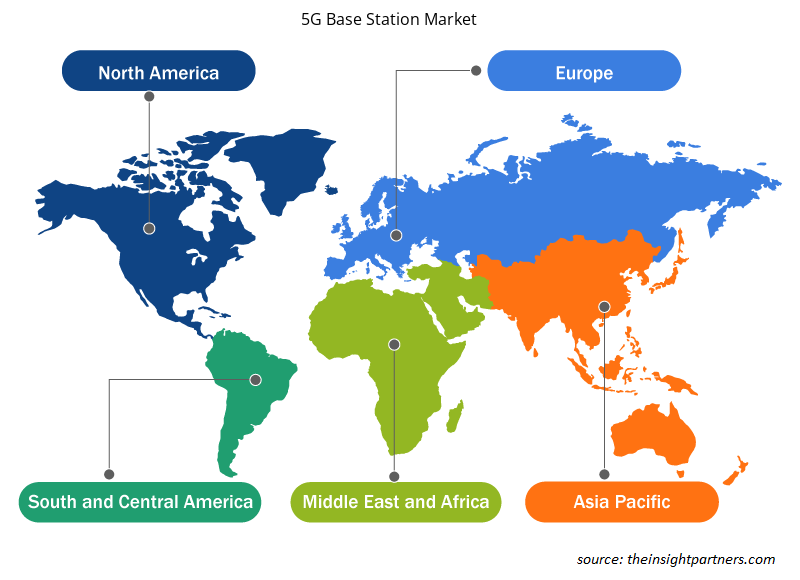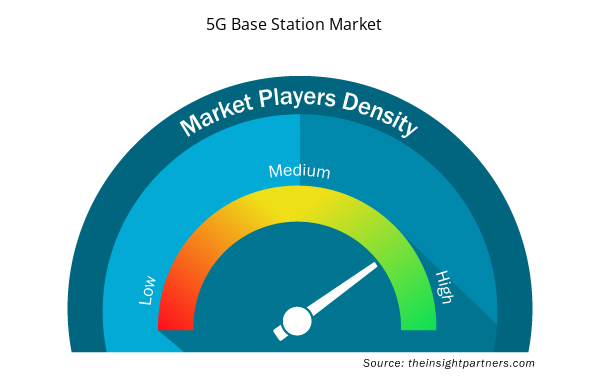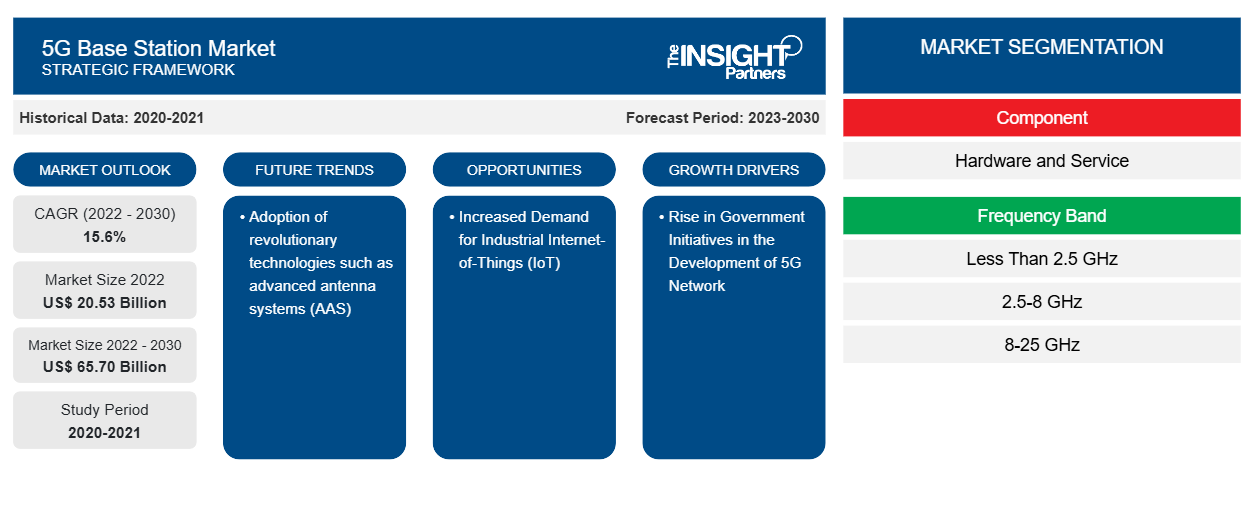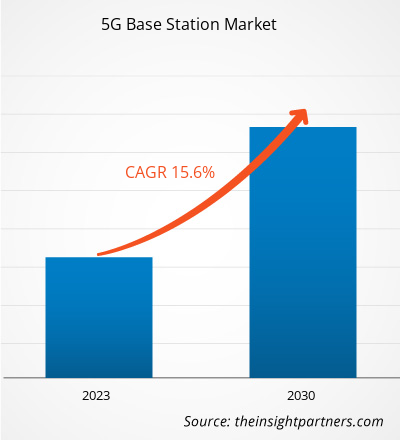Der Markt für 5G-Basisstationen soll von 20,53 Milliarden US-Dollar im Jahr 2022 auf 65,70 Milliarden US-Dollar im Jahr 2030 anwachsen. Der Markt wird zwischen 2022 und 2030 voraussichtlich eine durchschnittliche jährliche Wachstumsrate (CAGR) von 15,6 % verzeichnen. Die Einführung revolutionärer Technologien wie fortschrittlicher Antennensysteme (AAS) dürfte ein wichtiger Trend auf dem Markt bleiben.
Marktanalyse für 5G-Basisstationen
Die gestiegene Nachfrage nach dem industriellen Internet der Dinge (IIoT) und Edge Computing sind wichtige treibende Kräfte hinter der Einführung von 5G-Basisstationen.
Marktübersicht für 5G-Basisstationen
Die 5G-Basisstation ist das Schlüsselgerät des 5G-Netzwerks, das für drahtlose Abdeckung sorgt und die drahtlose Signalübertragung zwischen dem kabelgebundenen Kommunikationsnetzwerk und dem drahtlosen Terminal ermöglicht. Die Architektur und Form der Basisstationen wirken sich direkt auf die Art und Weise aus, wie 5G-Netzwerke bereitgestellt werden. Mit steigender Frequenz nimmt die Dämpfung während der Signalausbreitung zu, was zu einer höheren Basisstationsdichte des 5G- Netzwerks führt. Im Mai 2022 baute China 1,6 Millionen 5G-Basisstationen und war das erste Land der Welt, das ein groß angelegtes 5G-Netzwerk basierend auf dem unabhängigen Netzwerkmodell aufbaute. Im Jahr 2022 wurden in China 887.000 neue 5G-Basisstationen hinzugefügt. Die Zahl der 5G-Basisstationen erreichte ~2 Millionen, was mehr als 60 % der weltweiten Gesamtzahl entspricht.
Passen Sie diesen Bericht Ihren Anforderungen an
Sie erhalten kostenlose Anpassungen an jedem Bericht, einschließlich Teilen dieses Berichts oder einer Analyse auf Länderebene, eines Excel-Datenpakets sowie tolle Angebote und Rabatte für Start-ups und Universitäten.
- Holen Sie sich die wichtigsten Markttrends aus diesem Bericht.Dieses KOSTENLOSE Beispiel umfasst eine Datenanalyse von Markttrends bis hin zu Schätzungen und Prognosen.
Treiber und Chancen auf dem Markt für 5G-Basisstationen
Erhöhte Nachfrage nach industriellem Internet der Dinge (IoT) begünstigt den Markt
Mit der zunehmenden Nachfrage nach dem industriellen Internet der Dinge (IIoT) und Edge Computing steigt auch die Nachfrage nach privaten 5G-Netzwerken und kleinen Basisstationen. Ein privates 5G-Netzwerk ist ein dediziertes lokales Netzwerk (LAN), das Unternehmen, Industrie- und anderen Kunden einen verbesserten Internetzugang bietet. Netzwerkdienste der nächsten Generation werden voraussichtlich den Bedarf an entscheidender drahtloser Kommunikation für die öffentliche Sicherheit, Industriebetriebe und die Konnektivität kritischer Infrastrukturen erfüllen, während sie sich weiterentwickeln. Darüber hinaus wächst der globale Markt aufgrund des zunehmenden Bedarfs an ultrazuverlässigen Verbindungen mit geringer Latenz für Anwendungen, die auf dem industriellen Internet der Dinge (IIoT) basieren , darunter Roboter, kollaborative Industriekameras, Industriekameras und Industriesensoren.IIoT) and IIoT)
Zunahme staatlicher Initiativen zur Entwicklung des 5G-Netzes
Telekommunikation ist eine der am schnellsten wachsenden Branchen weltweit. Die US-Regierung und verschiedene Branchen übernehmen die 5G-Technologie schnell, um ihr volles Potenzial im Land auszuschöpfen und die digitale Geschäftstransformation voranzutreiben. So begegnet das Direktorat für Technologie, Innovation und Partnerschaften (TIP) der US-National Science Foundation im September 2023 den Herausforderungen im Zusammenhang mit der 5G-Kommunikationsinfrastruktur und dem 5G-Betrieb mit einer Investition von 25 Millionen US-Dollar, um fünf konvergente Teams zu fördern. Außerdem kündigte der US-Handelsminister im April 2023 die Einführung des Public Wireless Supply Chain Innovation Fund an, der 1,5 Milliarden US-Dollar in die Entwicklung interoperabler und offener Netzwerke investieren wird. Mit dieser Finanzierung können die USA und ihre globalen Verbündeten und Partner die Zukunft von 5G und der drahtlosen Technologie der nächsten Generation gestalten. Darüber hinaus ergreifen Regierungen verschiedener Länder im gesamten APAC-Raum mehrere Initiativen und investieren in 5G-Technologie.APAC are taking several initiatives and investing in 5G technology.
Segmentierungsanalyse des Marktberichts für 5G-Basisstationen
Wichtige Segmente, die zur Ableitung der Marktanalyse für 5G-Basisstationen beigetragen haben , sind Komponente, Frequenzbandplattform, Zelltyp und Endbenutzer.
- Basierend auf den Komponenten ist der Markt für 5G-Basisstationen in Hardware und Service unterteilt. Das Hardwaresegment hatte im Jahr 2022 einen erheblichen Marktanteil.
- Basierend auf dem Frequenzband wird der Markt für 5G-Basisstationen in weniger als 2,5 GHz, 2,5–8 GHz, 8–25 GHz und mehr als 25 GHz unterteilt. Das 2,5–8-GHz-Segment hatte im Jahr 2022 den größten Marktanteil.
- Basierend auf dem Zelltyp ist der Markt für 5G-Basisstationen in Makrozellen und Kleinzellen unterteilt. Das Kleinzellensegment ist weiter in Mikrozellen, Picozellen und Femtozellen unterteilt.macrocells and small cells. The small cell segment is further segmented into microcell, picocell, and femtocell.
- Basierend auf dem Endnutzer wird der Markt für 5G-Basisstationen in Industrie, Gewerbe und Privathaushalte unterteilt. Das gewerbliche Segment hatte im Jahr 2022 den größten Marktanteil.
Marktanteilsanalyse für 5G-Basisstationen nach Geografie
Der geografische Umfang des Marktberichts zu 5G-Basisstationen ist hauptsächlich in fünf Regionen unterteilt: Nordamerika, Asien-Pazifik, Europa, Naher Osten und Afrika sowie Süd- und Mittelamerika.
Nordamerika dominierte den Markt im Jahr 2022. Nordamerikanische Verbraucher nutzen zunehmend 5G-fähige Geräte wie Smartphones, Tablets und IoT-Geräte. Infolgedessen besteht ein wachsender Bedarf an 5G-Infrastruktur, um diese Geräte mit Hochgeschwindigkeitsdaten und geringer Latenz zu unterstützen. Die Telekommunikationsbetreiber in Nordamerika liefern sich einen harten Wettbewerb um die besten 5G-Dienste. Dieser Wettbewerb treibt den Einsatz weiterer 5G-Basisstationen voran, um eine bessere Abdeckung und höhere Geschwindigkeiten zu bieten. So ging Eastlink im August 2023 eine Partnerschaft mit Nokia ein, um sein 5G-Netzwerk in ganz Kanada zu verbessern. Im Rahmen dieser Partnerschaft modernisiert Eastlink sein Mobilfunknetz, indem es das AirScale-Portfolio von Nokia nutzt, einschließlich der 5G Radio Access Network (RAN)-Technologie, um hohe Geschwindigkeiten, beispiellose Leistung und erweiterte Netzwerkkapazität zu liefern.IoT gadgets. As a result, there is a growing need for 5G infrastructure to support these devices with high-speed data and low latency. Telecom operators in North America are engaged in fierce competition to provide the best 5G services. This competition drives the deployment of more 5G base stations to offer better coverage and faster speeds. For instance, in August 2023, Eastlink partnered with Nokia to enhance its 5G network across Canada. Under this partnership, Eastlink is modernizing its mobile network by using Nokia's AirScale portfolio, including 5G Radio Access Network (RAN) technology, to deliver fast speeds, unparalleled performance, and expanded network capacity.
Regionale Einblicke in den Markt für 5G-Basisstationen
Die regionalen Trends und Faktoren, die den Markt für 5G-Basisstationen im Prognosezeitraum beeinflussen, wurden von den Analysten von Insight Partners ausführlich erläutert. In diesem Abschnitt werden auch die Marktsegmente und die Geografie von 5G-Basisstationen in Nordamerika, Europa, im asiatisch-pazifischen Raum, im Nahen Osten und Afrika sowie in Süd- und Mittelamerika erörtert.

- Holen Sie sich die regionalen Daten für den 5G-Basisstationsmarkt
Umfang des Marktberichts zu 5G-Basisstationen
| Berichtsattribut | Details |
|---|---|
| Marktgröße im Jahr 2022 | 20,53 Milliarden US-Dollar |
| Marktgröße bis 2030 | 65,70 Milliarden US-Dollar |
| Globale CAGR (2022 - 2030) | 15,6 % |
| Historische Daten | 2020-2021 |
| Prognosezeitraum | 2023–2030 |
| Abgedeckte Segmente | Nach Komponente
|
| Abgedeckte Regionen und Länder | Nordamerika
|
| Marktführer und wichtige Unternehmensprofile |
|
Marktteilnehmerdichte für 5G-Basisstationen: Auswirkungen auf die Geschäftsdynamik verstehen
Der Markt für 5G-Basisstationen wächst rasant, angetrieben durch die steigende Nachfrage der Endnutzer aufgrund von Faktoren wie sich entwickelnden Verbraucherpräferenzen, technologischen Fortschritten und einem größeren Bewusstsein für die Vorteile des Produkts. Mit steigender Nachfrage erweitern Unternehmen ihr Angebot, entwickeln Innovationen, um die Bedürfnisse der Verbraucher zu erfüllen, und nutzen neue Trends, was das Marktwachstum weiter ankurbelt.
Die Marktteilnehmerdichte bezieht sich auf die Verteilung der Firmen oder Unternehmen, die in einem bestimmten Markt oder einer bestimmten Branche tätig sind. Sie gibt an, wie viele Wettbewerber (Marktteilnehmer) in einem bestimmten Marktraum im Verhältnis zu seiner Größe oder seinem gesamten Marktwert präsent sind.
Die wichtigsten auf dem Markt für 5G-Basisstationen tätigen Unternehmen sind:
- Alpha Networks Inc,
- Airspan Networks Holdings Inc
- Baicells Technologies North America Inc
- Commscope Holding Co Inc
- Huawei Technologies Co Ltd
- NEC Corp
Haftungsausschluss : Die oben aufgeführten Unternehmen sind nicht in einer bestimmten Reihenfolge aufgeführt.

- Überblick über die wichtigsten Akteure auf dem Markt für 5G-Basisstationen
Neuigkeiten und aktuelle Entwicklungen zum 5G-Basisstationsmarkt
Der Markt für 5G-Basisstationen wird durch die Erfassung qualitativer und quantitativer Daten nach Primär- und Sekundärforschung bewertet, die wichtige Unternehmensveröffentlichungen, Verbandsdaten und Datenbanken umfasst. Einige der Entwicklungen auf dem Markt für 5G-Basisstationen sind unten aufgeführt:
- Alpha Networks Inc. gab bekannt, dass es am Mobile World Congress (MWC 2024) in Barcelona teilnimmt und seine O-RAN Radio Unit (O-RU)-Lösung der nächsten Generation für 5G-Basisstationen im MWC Taiwan Pavilion präsentieren wird, der vom Industrial Development Bureau, MOEA, organisiert wird. (Quelle: Alpha Networks Inc, Pressemitteilung, Februar 2024)
- BLiNQ Networks hat sich mit EdgeQ zusammengetan, um die PCW-400i auf den Markt zu bringen, eine fortschrittliche 5G-Kleinzellen-Basisstation, die auf dem System-on-Chip (SoC) von EdgeQ basiert. Laut EdgeQ gehört das neue Produkt zu einer neuen Klasse von 5G NR Wireless Network Edge-Produkten. Es hat einen kompakten Formfaktor, der sich an vielfältige Anwendungen anpassen lässt, von öffentlichen Orten, Lagerhallen, Industrieräumen, Einzelhandelsflächen, akademischen Einrichtungen bis hin zu Büroeinsätzen. (Quelle: BLiNQ Networks, Pressemitteilung, Oktober 2023)
Marktbericht zu 5G-Basisstationen – Abdeckung und Ergebnisse
Der Bericht „Marktgröße und Prognose für 5G-Basisstationen (2020–2030)“ bietet eine detaillierte Analyse des Marktes, die die folgenden Bereiche abdeckt:
- Marktgröße und Prognose für 5G-Basisstationen auf globaler, regionaler und Länderebene für alle wichtigen Marktsegmente, die im Rahmen des Berichts abgedeckt sind
- Markttrends für 5G-Basisstationen sowie Marktdynamik wie Treiber, Einschränkungen und wichtige Chancen
- Detaillierte PEST/Porters Five Forces- und SWOT-Analyse
- Marktanalyse für 5G-Basisstationen, die wichtige Markttrends, globale und regionale Rahmenbedingungen, wichtige Akteure, Vorschriften und aktuelle Marktentwicklungen umfasst
- Branchenlandschaft und Wettbewerbsanalyse mit Marktkonzentration, Heatmap-Analyse, prominenten Akteuren und aktuellen Entwicklungen für den Supraleitermarkt
- Detaillierte Firmenprofile
- Historische Analyse (2 Jahre), Basisjahr, Prognose (7 Jahre) mit CAGR
- PEST- und SWOT-Analyse
- Marktgröße Wert/Volumen – Global, Regional, Land
- Branche und Wettbewerbsumfeld
- Excel-Datensatz



Report Coverage
Revenue forecast, Company Analysis, Industry landscape, Growth factors, and Trends

Segment Covered
This text is related
to segments covered.

Regional Scope
North America, Europe, Asia Pacific, Middle East & Africa, South & Central America

Country Scope
This text is related
to country scope.
Häufig gestellte Fragen
The market is expected to grow at a CAGR of 15.6% over the forecast period.
The estimated value of the 5G Base Station market is expected to reach US$ 65.70 billion by 2030.
North America dominated the 5G Base Station market in 2022.
The increased demand for industrial internet-of-things (IIoT) and edge computing, are important driving forces behind 5G Base Station adoption.
Alpha Networks Inc., Airspan Networks Holdings Inc., Baicells Technologies North America Inc., Commscope Holding Co Inc, and Huawei Technologies Co Ltd are among the leading players in the 5G Base Station market.
The adoption of revolutionary technologies such as advanced antenna systems (AAS) is likely to remain a key trend in the market.
Trends and growth analysis reports related to Electronics and Semiconductor : READ MORE..
The List of Companies - 5G Base Station Market
- Alpha Networks Inc
- Airspan Networks Holdings Inc
- Baicells Technologies North America Inc
- Commscope Holding Co Inc
- Huawei Technologies Co Ltd
- NEC Corp
- Nokia Corp
- Samsung Electronics Co Ltd
- Telefonaktiebolaget LM Ericsson
- ZTE Corp
The Insight Partners performs research in 4 major stages: Data Collection & Secondary Research, Primary Research, Data Analysis and Data Triangulation & Final Review.
- Data Collection and Secondary Research:
As a market research and consulting firm operating from a decade, we have published and advised several client across the globe. First step for any study will start with an assessment of currently available data and insights from existing reports. Further, historical and current market information is collected from Investor Presentations, Annual Reports, SEC Filings, etc., and other information related to company’s performance and market positioning are gathered from Paid Databases (Factiva, Hoovers, and Reuters) and various other publications available in public domain.
Several associations trade associates, technical forums, institutes, societies and organization are accessed to gain technical as well as market related insights through their publications such as research papers, blogs and press releases related to the studies are referred to get cues about the market. Further, white papers, journals, magazines, and other news articles published in last 3 years are scrutinized and analyzed to understand the current market trends.
- Primary Research:
The primarily interview analysis comprise of data obtained from industry participants interview and answers to survey questions gathered by in-house primary team.
For primary research, interviews are conducted with industry experts/CEOs/Marketing Managers/VPs/Subject Matter Experts from both demand and supply side to get a 360-degree view of the market. The primary team conducts several interviews based on the complexity of the markets to understand the various market trends and dynamics which makes research more credible and precise.
A typical research interview fulfils the following functions:
- Provides first-hand information on the market size, market trends, growth trends, competitive landscape, and outlook
- Validates and strengthens in-house secondary research findings
- Develops the analysis team’s expertise and market understanding
Primary research involves email interactions and telephone interviews for each market, category, segment, and sub-segment across geographies. The participants who typically take part in such a process include, but are not limited to:
- Industry participants: VPs, business development managers, market intelligence managers and national sales managers
- Outside experts: Valuation experts, research analysts and key opinion leaders specializing in the electronics and semiconductor industry.
Below is the breakup of our primary respondents by company, designation, and region:

Once we receive the confirmation from primary research sources or primary respondents, we finalize the base year market estimation and forecast the data as per the macroeconomic and microeconomic factors assessed during data collection.
- Data Analysis:
Once data is validated through both secondary as well as primary respondents, we finalize the market estimations by hypothesis formulation and factor analysis at regional and country level.
- Macro-Economic Factor Analysis:
We analyse macroeconomic indicators such the gross domestic product (GDP), increase in the demand for goods and services across industries, technological advancement, regional economic growth, governmental policies, the influence of COVID-19, PEST analysis, and other aspects. This analysis aids in setting benchmarks for various nations/regions and approximating market splits. Additionally, the general trend of the aforementioned components aid in determining the market's development possibilities.
- Country Level Data:
Various factors that are especially aligned to the country are taken into account to determine the market size for a certain area and country, including the presence of vendors, such as headquarters and offices, the country's GDP, demand patterns, and industry growth. To comprehend the market dynamics for the nation, a number of growth variables, inhibitors, application areas, and current market trends are researched. The aforementioned elements aid in determining the country's overall market's growth potential.
- Company Profile:
The “Table of Contents” is formulated by listing and analyzing more than 25 - 30 companies operating in the market ecosystem across geographies. However, we profile only 10 companies as a standard practice in our syndicate reports. These 10 companies comprise leading, emerging, and regional players. Nonetheless, our analysis is not restricted to the 10 listed companies, we also analyze other companies present in the market to develop a holistic view and understand the prevailing trends. The “Company Profiles” section in the report covers key facts, business description, products & services, financial information, SWOT analysis, and key developments. The financial information presented is extracted from the annual reports and official documents of the publicly listed companies. Upon collecting the information for the sections of respective companies, we verify them via various primary sources and then compile the data in respective company profiles. The company level information helps us in deriving the base number as well as in forecasting the market size.
- Developing Base Number:
Aggregation of sales statistics (2020-2022) and macro-economic factor, and other secondary and primary research insights are utilized to arrive at base number and related market shares for 2022. The data gaps are identified in this step and relevant market data is analyzed, collected from paid primary interviews or databases. On finalizing the base year market size, forecasts are developed on the basis of macro-economic, industry and market growth factors and company level analysis.
- Data Triangulation and Final Review:
The market findings and base year market size calculations are validated from supply as well as demand side. Demand side validations are based on macro-economic factor analysis and benchmarks for respective regions and countries. In case of supply side validations, revenues of major companies are estimated (in case not available) based on industry benchmark, approximate number of employees, product portfolio, and primary interviews revenues are gathered. Further revenue from target product/service segment is assessed to avoid overshooting of market statistics. In case of heavy deviations between supply and demand side values, all thes steps are repeated to achieve synchronization.
We follow an iterative model, wherein we share our research findings with Subject Matter Experts (SME’s) and Key Opinion Leaders (KOLs) until consensus view of the market is not formulated – this model negates any drastic deviation in the opinions of experts. Only validated and universally acceptable research findings are quoted in our reports.
We have important check points that we use to validate our research findings – which we call – data triangulation, where we validate the information, we generate from secondary sources with primary interviews and then we re-validate with our internal data bases and Subject matter experts. This comprehensive model enables us to deliver high quality, reliable data in shortest possible time.


 Holen Sie sich ein kostenloses Muster für diesen Bericht
Holen Sie sich ein kostenloses Muster für diesen Bericht